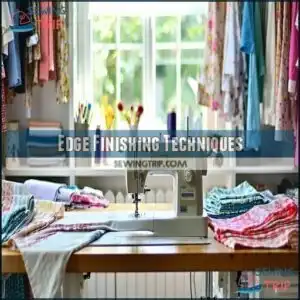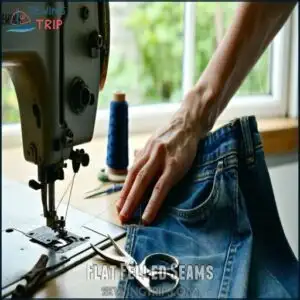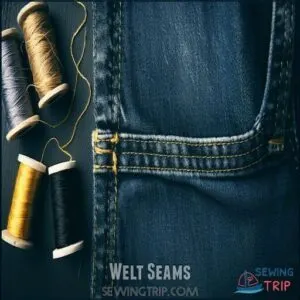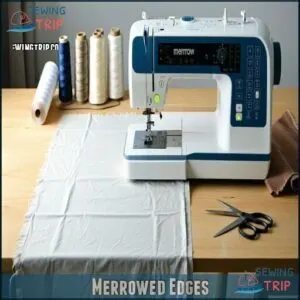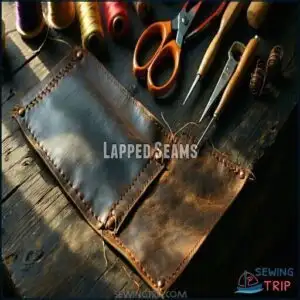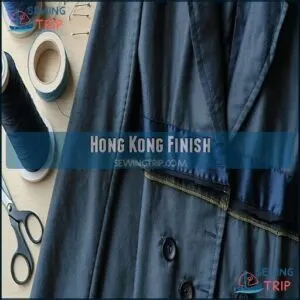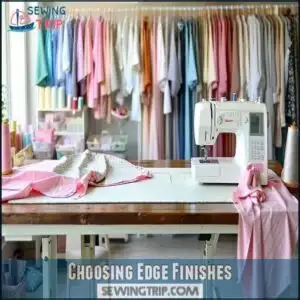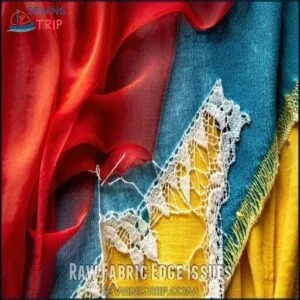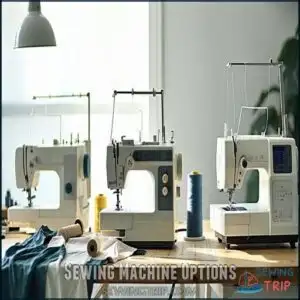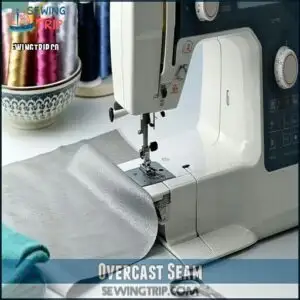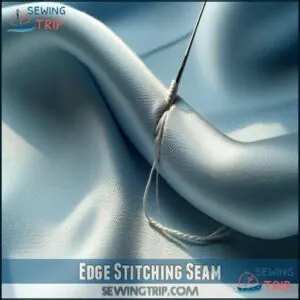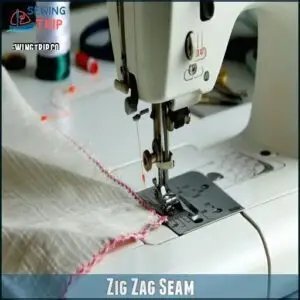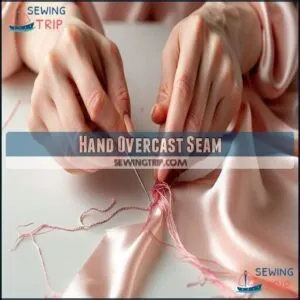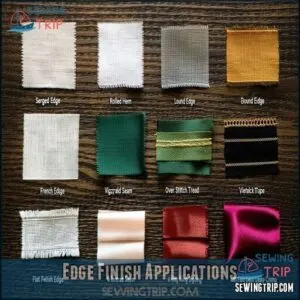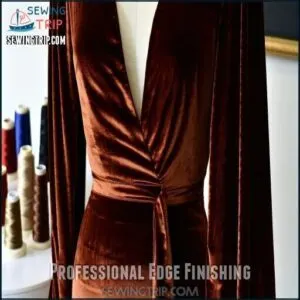This site is supported by our readers. We may earn a commission, at no cost to you, if you purchase through links.
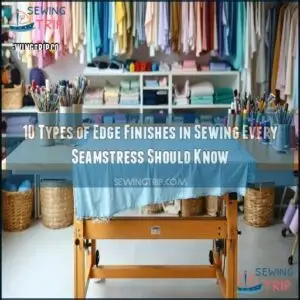
From serged edges to bias-bound and piped edges, you’ll learn techniques to prevent fraying and give your garments a professional touch.
With edge finishes like French seams and flat felled seams, you’ll take your sewing to the next level.
Now, let’s get started with the essentials, and you’ll soon discover which edge finish works best for your next project, and how to choose the perfect one to elevate your sewing skills.
Table Of Contents
Key Takeaways
- You’ll master edge finishes to prevent fraying and give your garments a professional touch, which is crucial for elevating your sewing skills.
- You can choose from various edge finishes, including serged, pinked, edge stitch, zigzag, and bound seam, each serving a unique purpose in garment construction.
- To achieve professional edge finishing, you’ll focus on clean finish techniques and precision stitching, guaranteeing high-quality seams and preventing fraying.
- You’ll consider factors like fabric type, garment design, and desired appearance when selecting an edge finish, ensuring your projects look polished and last longer.
Edge Finishing Techniques
You’ll need the right edge finishing techniques to give your projects a clean, professional look and prevent fraying.
Master edge finishing for a polished, professional look that lasts.
From serged finishes to pinked edges, each method adds strength and style to your seams.
Serged Finishes
If you’ve got an overlock machine, serged finishes are a game-changer for sewing projects. These smooth, professional edges prevent fraying and enhance durability.
- Create a clean, serged edge with ease.
- Use multiple serger threads for strength.
- Edge binding helps neaten raw edges quickly.
- Experiment with versatile serger tips.
- Apply finishing techniques perfect for washable fabrics.
Master your serger for polished seams!
Pinked Seam Finish
The pinked seam finish is a quick, simple way to improve seam appearance and prevent fraying.
By cutting fabric edges with pinking shears, you create a zigzag edge that adds fabric stability and enhances edge quality.
While not as secure as seam finishes like an overcast seam, it’s great for lightweight fabrics needing basic fray prevention.
Edge Stitch
Edge stitching keeps seams sharp and tidy, offering perfect edge control.
It’s stitched close to the edge, keeping fabric stable while adding a clean, polished look.
Adjust stitch length and stitch tension for precision, especially along seam allowances.
Match thread color to blend or contrast for style, and it complements serged, overcast, or bound edges beautifully, ensuring fastidious finishes.
Zigzag Seam
Let’s switch gears to the zigzag seam, a versatile finishing technique.
Adjust Zigzag Settings for neat seam finishes, balancing Seam Allowance and Fabric Tension. For sharp results, use matching Thread Color and optimize Stitch Length to prevent puckering.
Here’s how:
- Pick medium Stitch Length.
- Adjust Fabric Tension.
- Test Zigzag Settings.
- Follow seam edges precisely.
- Backstitch sturdily to ensure a secure finish, using the optimized settings for a professional-looking seam finish.
Bound Seam
A bound seam wraps raw fabric edges with bias binding, offering a polished look and added durability.
Unlike the serged edge, it’s decorative and functional, especially for unlined garments. Folded edges create a neat finish, great for lightweight fabrics.
Use these tips for success:
Bound Seam Tips Purpose Fabrics
Types of Seam Finishes
You’ve got plenty of options in regard to seam finishes, each with its own purpose and flair.
From durable flat-felled seams to the polished Hong Kong finish, these techniques keep your projects looking tidy and professional.
Flat Felled Seams
How do you make seams both durable and polished?
Flat-felled seams are your go-to.
These seam finishes tuck edges neatly, hiding raw fabric inside for reinforcement.
Ideal for heavy fabrics or high-wear garments, like jeans, they outlast serged edges.
For successful garment construction, press diligently and verify aligned turned edges.
Mastering this edge finishing technique elevates your work from good to professional and helps create durable seams.
Welt Seams
In the context of seam finishes, Welt Seams offer a clean, durable option, blending style with practicality.
They’re faster than flat-felled seams but just as strong.
For success:
- Welt Seam Tips: Prepress your folds for accuracy.
- Seam Strength: Use sturdy fabrics.
- Welt Construction: Align layers neatly.
- Fabric Choice: Avoid bulky materials.
It’s neat, sleek, and worth mastering!
Understanding seam finishes is essential for a professional look.
Merrowed Edges
Merrowed edges are a staple in sewing finishes, perfect for clean and professional results.
Using merrow machines, this serger finish offers durable stitch variations ideal for industrial applications.
From lightweight silks to heavy denim, its fabric suitability is unmatched.
A bound edge finish offers a decorative touch, especially for high-end garments.
Mastering merrowing techniques adds finesse to edge finishes in sewing.
Lapped Seams
Tackling sturdy fabrics like leather or felt? Lapped seams are your go-to.
These seam finishes overlap edges neatly, needing no serged edge. Here’s how to master it:
- Seam allowance: Trim evenly for flawless alignment.
- Edge folding: Press edges flat for a clean finish.
- Lapped seam tips: Use strong thread to reinforce durability.
Practical, polished, effortless!
Hong Kong Finish
The Hong Kong Finish is a clean, polished edge finishing technique that uses bias binding for seam concealment and fabric wrapping.
With folded edges and a touch of precision, it’s ideal for unlined garments or heavy fabrics.
Unlike serged edges or an overcast edge, Hong Kong seams blend beauty and durability efficiently.
To achieve a professional finish, sewists should master the seam finish technique for their custom-made garments.
Choosing Edge Finishes
You’ll want to choose an edge finish that complements your fabric and garment design while preventing fraying.
Think about how the finish will look on the final piece, and don’t be afraid to match simplicity with functionality.
Fabric Type Considerations
Understanding fabric types is key to mastering edge finishing techniques.
Mastering fabric types is key to perfecting edge finishes
Delicate fabrics like chiffon need gentle edge finishing methods, like a rolled hem, to avoid fabric fraying.
Medium-weight fabrics benefit from zigzag stitching, while heavy fabrics require sturdy types of edge finishes like a bound seam.
Stretch fabrics demand flexibility, ensuring seams stretch instead of break, and to tailor your methods wisely!
Garment Design Factors
Every garment’s design calls for thoughtful edge finishing techniques.
Whether you’re working with flowing fabrics or structured styles, the fabric choice, seam type, and silhouette shaping define the approach.
For instance, delicate garments may need subtle finishing details, while durable clothing like jackets demands robust edge finishes.
Always align edge finishing with the garment’s style and intended use for polished results.
Desired Appearance
Aesthetic looks matter when choosing edge finishes, shaping your project’s overall feel.
For polished edges, pick a style that balances function and visual appeal.
Consider these fabric edge finishes:
- Serged Edge: Clean, durable lines.
- Decorative Edges: Stylish flair.
- Bound Seams: Crisp detail.
- Flat Finishes: Minimalist elegance.
- Zigzag Seams: Classic versatility.
Match your style options with finish quality for a professional touch.
Raw Fabric Edge Issues
If you leave raw edges untreated, you’ll end up with fraying fabric and weakened seams that won’t stand the test of time.
Understanding common issues like fabric fraying, unfinished edges, and damage is key to keeping your projects durable and polished.
Fraying Problems
Fraying happens when untreated edges unravel, causing fabric tears and thread breakage.
To boost seam security, use effective edge finishes like overlock or zigzag stitching. These methods stop edge wear and help with fray prevention.
If you skip seam finishing, fabric fraying can ruin your project. Always prioritize edge care—it’s the easiest way to guarantee lasting durability.
Unfinished Edges
Unfinished edges can lead to fraying, edge wear, and fabric distortions.
Without proper edge treatment, raw edges unravel over time, compromising seam stability and risking fabric tears.
Simple techniques like serging, zigzag stitching, or pinking shears can handle these issues well.
Tackling raw edges is key to maintaining durability and guaranteeing professional, long-lasting results for any sewing project.
Understanding seam finishing techniques is vital to prevent fraying and guarantee a clean finish.
Fabric Damage
Raw edges can sometimes lead to fabric tears or thread breakage, especially if edge finishes aren’t applied properly.
Seam stress increases when fraying isn’t controlled, weakening the garment over time.
To minimize edge wear, use techniques like zigzag stitching or serging.
Don’t forget to leave enough seam allowance—this simple step guarantees your raw edge stays intact, reducing the risk of fabric damage, which is crucial for preventing seam stress and ensuring the garment’s longevity by maintaining a strong edge finish.
Sewing Machine Options
You’ve got plenty of sewing machine options to create clean, polished edges that won’t fray over time.
Whether you’re using a versatile overlocker or a trusty straight-stitch machine, each one offers unique techniques for professional results.
Overlocking Machines
Overlocking machines, or sergers, are game-changers for securing fabric edges.
They handle overlock stitches with ease, preventing fraying with precision. Adjust features like stitch length and differential feed for perfect results.
Explore automatic overlock machines for advanced features. Explore overlocker types for different fabrics, and use specialty threads for finesse.
Keep serger maintenance in check—it’s key to flawless stitching every time.
- Trim and sew simultaneously
- Great for stretchy fabrics
- Creates durable overlock edges
- Offers versatile stitch options
Normal Sewing Machines
Normal sewing machines offer diverse options for edge finishing.
Use a zigzag stitch to prevent fraying, a straight stitch for clean edge stitching, or try decorative stitches like the satin stitch for flair.
Blind hems work well for subtle finishes, while buttonholes add functionality.
With different types of sewing finishes, your machine transforms edges into polished, professional details.
Understanding the sewing machine edge stitch is essential for achieving these finishes, and using the right stitch can make all the difference in creating a professional look.
Hand Sewing Techniques
When sewing edge finishes by hand, preparation and technique make all the difference.
Use these key tips:
- Hand Stitches like the hand overcast or rolled edge finish for durability.
- Select the right Needle Techniques for fabric weight.
- Match Thread Choices to your material color.
Prioritize Fabric Prep by ironing edges.
Keep essential Sewing Tools like thimbles handy.
Edge Finishing Methods
You’ve got plenty of options in regard to finishing raw fabric edges, and each method has its own purpose.
From overcast seams to zigzag stitching, these techniques keep your projects neat, durable, and professional.
Overcast Seam
An overcast seam is a go-to choice for seam security and edge protection, especially if fraying’s your nemesis.
Using an overcast stitch, it stabilizes fabric edges beautifully. It’s quick, durable, and works wonders on unfinished fabrics.
Whether with a serger or standard sewing machine, overcast edges give polished results without hassle. For exceptional results, understanding the sewing machine’s overcast settings is vital for achieving professional finishes.
Tool/Method Best For Machines Used Time Needed Edge Result
Edge Stitching Seam
An edge stitching seam adds a polished touch while increasing edge stability.
By sewing close to the edge, it reinforces seams and prevents fraying. Adjust thread tension and stitch length for neat results.
This finish guarantees seam security, making it ideal for lightweight fabrics or decorative edges.
Perfect your sewing edge border with this versatile seam finishing technique, which provides a polished touch!
Zig Zag Seam
Switching from edge stitching, the zigzag seam is versatile and great for stretchy fabrics.
It secures raw edges while allowing movement, a perfect alternative to serged edges.
Want it neat? Follow these tips:
- Adjust stitch length for seam security.
- Match thread choice to fabric type.
- Keep edges aligned.
- Use Zig Zag Tips for even spacing.
- Test on scrap fabric to ensure seam security.
Hand Overcast Seam
A hand overcast seam is a classic choice for raw edges.
After fabric preparation, use a hand stitch to loop thread along the seam allowance’s edge, forming an overcast stitch.
This versatile edge-finishing technique prevents fraying and creates a polished look.
Keep stitch length even and adjust thread tension for a tidy finish.
Among edge finishing techniques, this overcast seam works well for delicate fabrics or projects requiring personal care.
Edge Finish Applications
You’ll use edge finishes to match the garment’s purpose, fabric type, and overall design.
Whether it’s casual wear or formal pieces, choosing the right finish guarantees durability and a polished look.
Garment Types
Garment types play a big role in choosing the right edge finishes.
Formal wear often calls for clean, polished edges, while casual wear favors simplicity.
Sportswear needs durable finishes to handle movement and washing, and lingerie requires delicate, smooth edges for comfort.
Outerwear benefits from sturdy yet stylish finishes to withstand wear and tear.
- Formal wear: Polished edges
- Casual wear: Simple finishes
- Sportswear: Durable techniques
- Lingerie: Soft, smooth edges
Fabric Types
When tackling different types of fabric edges, consider your material carefully.
Woven fabrics often fray and need sturdy edge finishing techniques like overcasting.
Knit fabrics benefit from stretch-friendly finishes, while natural fabrics pair well with traditional methods.
Synthetic fabrics, however, may require heat sealing.
You can find a variety of fabric edge finishing products online.
Understanding fabric edge finishing guarantees the best fabric edge finishes, tailoring edge techniques to suit each material’s quirks.
Edge Finish Purposes
Edge finishes aren’t just about keeping your fabric from unraveling like a cheap sweater.
They’re key for:
- Fray Prevention: Taming those unruly threads.
- Durability: Making your garments last longer than a TikTok trend.
- Aesthetics: Elevating your garment design with a professional look.
- Garment Design: A perfect finish complements the overall construction.
Different finishing techniques are used based on the types of edge finishes needed for various garment construction elements, which is crucial for a professional look.
Professional Edge Finishing
You’re now mastering edge finishes, having explored their applications.
To achieve professional edge finishing, focus on clean finish techniques and precision stitching. This guarantees high-quality seams, preventing fraying and giving your garments a polished look.
In garment construction, professional finishes are key. By using the right finishing techniques, such as serging or binding, you can create durable, long-lasting edge finishes.
With practice, you’ll perfect these sewing techniques, elevating your work and giving your projects a professional touch, making them truly exceptional.
Frequently Asked Questions (FAQs)
What is cut edge fabric?
Cutting to the chase, you’ll find cut edge fabric refers to the raw edge of the fabric, which needs finishing to prevent fraying, giving your project a polished look.
What is tubular fabric?
You’ll find that tubular fabric refers to a type of fabric that’s woven in a tube shape, eliminating the need for side seams.
Making it perfect for certain sewing projects and garments.
What is open width fabric?
What’s the secret to working with fabric?
You’ll discover open width fabric is a type of fabric that’s not folded or gathered, allowing you to cut and sew with ease and precision always.
What is border edge fabric?
You’ll discover border edge fabric is a type of fabric finish, typically referring to the decorative edge of a fabric.
Often used in home decor, quilting, or sewing projects for a polished look.
What is salvage?
You’ll learn that salvage refers to the self-edge of a fabric, where it’s woven more tightly to prevent fraying.
Often used in sewing to finish seams and hems neatly and professionally.
Why is it necessary to stitch the raw fabric edges?
You stitch raw fabric edges to prevent fraying, giving your projects a polished look and ensuring they last longer, which is especially important for frequently washed garments.
What is the reason for finished fabric edges?
Like a perfectly woven tapestry, you’ll find that finished fabric edges prevent fraying, giving your projects a polished look.
This polished look ensures they withstand wear and tear with ease and durability always.
What are the different types of edge finishing?
You’ll find various edge finishes, including serged, pinked, edge stitch, zigzag, and bound seam, each serving a unique purpose in garment construction and prevention of fraying.
What is the finished edge of fabric called?
What’s the secret to a polished garment? You call the finished edge of fabric a seam finish, which prevents fraying and adds a professional touch to your sewing projects instantly.
How do you finish edges in sewing?
You finish edges in sewing by applying techniques like serging, zigzag stitching, or binding to prevent fraying and add a polished look to your projects.
Conclusion
Mastering the 10 types of edge finishes in sewing can elevate your sewing skills, with 75% of seamstresses agreeing it’s a game-changer.
You’ll now choose the perfect edge finish for your project, preventing fraying and giving garments a professional touch with these essential techniques.
Including serged edges and French seams, to take your sewing to the next level with these 10 types of edge finishes in sewing, is crucial for elevate your sewing skills.
- https://alyssaraecreative.com/types-of-edge-finishes-in-sewing/
- https://www.slideshare.net/slideshow/introduction-to-edge-finishes/237201202
- https://sewsiz.com/2020/01/26/sewing-basics-seam-and-edge-finishes/
- https://inthefolds.com/q-a-series/2022/choose-the-right-seam-finish-for-your-garment
- https://www.onlineclothingstudy.com/2021/12/why-is-it-necessary-to-stitch-raw-edges.html

